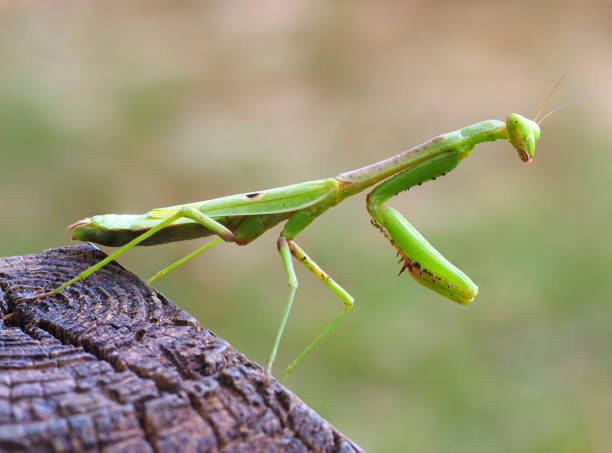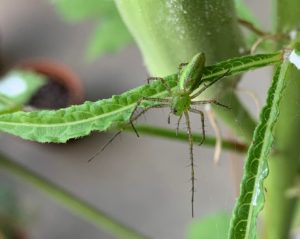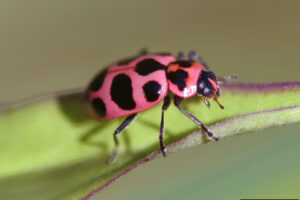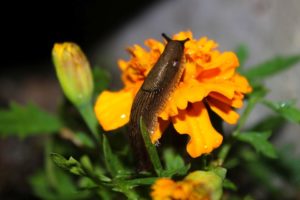The praying mantis is one of the most fascinating creatures in the insect world. It belongs to the genus Mantis and derives its name from the seemingly religious pose it strikes when its long front legs are folded as if in prayer. Mantis, which means diviner in Greek, was thought by ancient Greeks to have supernatural powers.
There are more than 2,400 species of mantises located all over the world. They typically measure 1 to 3 inches (2.5 to 7.5 cm) in length, although some living in more tropical regions grow up to 8 inches (20 cm) or more.
Praying Mantis Description
Praying mantises have triangular heads and flexible necks that can turn from side to side while their bodies remain stationary. A feat only mantids can perform. The placement of their large compound eyes, along with their 3-D vision, gives them a predatory advantage. Moreover, a fovea, an area of photoreceptor cells, in each eye helps them focus on and track potential prey.
Another characteristic these amazing insects possess is their hunting prowess. They use the overlapping rows of spikes on their forelegs to capture and impale their prey. While the predator holds its victim down, it uses its powerful, sharp mandibles to consume its captive alive.
Usually, the males of some mantis species have fully developed wings that are capable of flight, an asset both in hunting prey and locating females to mate. Other species, however, have underdeveloped wings that are not large enough to bear the insect’s weight.
Mantises are usually green or some variation of brown, but many species are experts at camouflage. Other species, like the tropical orchid mantis (Hymenopus coronatus) of Southeast Asia, blend in perfectly with the flowers they inhabit.

Life Cycle
Depending on the weather, which can affect the rate of maturation, praying mantises typically mate in the summer, with the male flying to locate the female. True to rumor, the female may eat the male during mating or immediately afterward, sometimes biting its head off. If the male escapes this fate, it may fly off to mate with other females.
Periodically throughout the summer, the female mantis will lay hundreds of eggs in masses. She will cover each grouping of eggs in protective foam to create an ootheca, which is Latin for egg container. Each ootheca will measure approximately 1.5 inches (3.8 cm). Oothecas can be found on branches, tree bark, fences, or other surfaces, even vertical ones, thanks to the stickiness of the ootheca when it is first made. Egg laying will continue until the fall months, but when the weather becomes too cold for her, the female mantis will die.
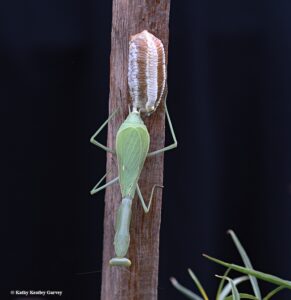
The eggs will overwinter until the spring when the nymphs emerge from the ootheca, all within a short period of time. Soon, however, they will scatter to live alone. The nymphs will go through several molting stages until they reach adulthood. Unfortunately, only a fraction will survive the process.
Depending on the species, mantises live anywhere from several weeks for the smaller species up to a year for the larger ones.
Friend or Foe?
Praying mantises are carnivores that will only eat live food. They primarily target insects like flies, mosquitoes, aphids, crickets, grasshoppers, and moths. Since these are considered garden pests, most gardeners view mantises as a means of free, organic pest control. On the other hand, these garden predators will also eat beneficial insects like bees, butterflies, and other pollinators. Some species will also eat frogs, lizards, and small birds like hummingbirds. Nevertheless, overall, the praying insects are thought to be more of a friend than they are a foe.
Common North American Species
There are quite a few species of praying mantises in North America. The three most common are the Carolina mantis (Stagmomantis carolina), which is native to this continent, the Chinese mantis (Tenodera sinensis), and the European mantis (Mantis religiosa). Although not native to North America, the latter two have become naturalized.
The Carolina mantis is green to mottled brown and measures between 2 and 2.5 inches (5 and 6.4 cm) in length. The females have smaller wings, and their egg cases (oothecas) are flatter and less spherical than that of the Chinese mantises, and are often laid on vertical surfaces.

The Chinese mantis, on the other hand, grows up to four inches (10.2 cm) in length and is the largest of the three common varieties. It is not native to North America but was introduced as a pest-control method. It is green to brown in color and bears a pale greenish-yellow stripe on its wings. Most notably, it has vertical stripes down its forehead. It has a bit of a reputation for catching hummingbirds when they come to drink from flowers or bird feeders. However, this may not occur as often as is commonly thought.
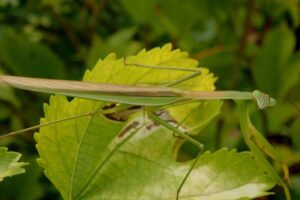
Like the Chinese mantis, the European mantis is also a non-native. It grows up to three inches (10.2 cm) in length and is dark green to light brown in color. If you look under its front legs, you may be able to observe a black and white marking that resembles an eye.
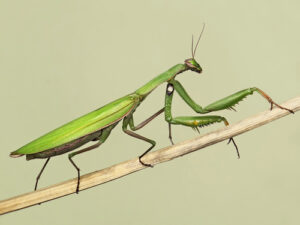
Interestingly, mantises are among the most favorite insects that are kept as pets. You should know, however, that while their bite is not poisonous, their powerful, spiked forelegs can deliver a painful blow.
Now that you have learned more about this incredible insect, perhaps you will be more inclined to let it roam your garden. If you would like to know what you can do to attract praying mantises to your garden, check out this helpful article.
Thank you for reading this article! If you found it interesting or helpful, please consider sharing it with others via email and social media!
